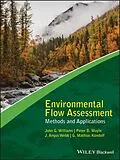Provides critiques of current practices for environmental flow assessment and shows how they can be improved, using case studies.
In Environmental Flow Assessment: Methods and Applications, four leading experts critique methods used to manage flows in regulated streams and rivers to balance environmental (instream) and out-of-stream uses of water. Intended for managers as well as practitioners, the book dissects the shortcomings of commonly used approaches, and offers practical advice for selecting and implementing better ones.
The authors argue that methods for environmental flow assessment (EFA) can be defensible as well as practicable only if they squarely address uncertainty, and provide guidance for doing so. Introductory chapters describe the scientific and social reasons that EFA is hard, and provide a brief history. Because management of regulated streams starts with understanding freshwater ecosystems, Environmental Flow Assessment: Methods and Applications includes chapters on flow and organisms in streams. The following chapters assess standard and emerging methods, how they should be tested, and how they should (or should not) be applied. The book concludes with practical recommendations for implementing environmental flow assessment.
* Describes historical and recent trends in environmental flow assessment
* Directly addresses practical difficulties with applying a scientifically informed approach in contentious circumstances
* Serves as an effective introduction to the relevant literature, with many references to articles in related scientific fields
* Pays close attention to statistical issues such as sampling, estimation of statistical uncertainty, and model selection
* Includes recommendations for methods and approaches
* Examines how methods have been tested in the past and shows how they should be tested today and in the future
Environmental Flow Assessment: Methods and Applications is an excellent book for biologists and specialists in allied fields such as engineering, ecology, fluvial geomorphology, environmental planning, landscape architecture, along with river managers and decision makers.
Autorentext
John G. Williams, PhD, is an independent scientist who has written influential papers on environmental flow assessment, as well as on a monograph on Chinook salmon, steelhead, and their habitats in California's Central Valley. He served two terms as an elected director of a powerful water management district and was special master for an important legal case concerning environmental flows.
Peter B. Moyle, PhD, is Distinguished Professor Emeritus in the Department of Wildlife, Fish, and Conservation Biology and the Center for Watershed Sciences, University of California Davis. He has been studying the effects of altered flows on fish since the 1970s.
J. Angus Webb, PhD, is a senior lecturer in the Water, Environment and Agriculture Program within the Melbourne School of Engineering, University of Melbourne. He has particular expertise in the monitoring, evaluation, and adaptive management of environmental flow programs.
G. Mathias Kondolf, PhD, is a Professor in the Departments of Landscape Architecture & Environmental Planning and Geography, University of California Berkeley, and fellow of the Collegium, Institute of Advanced Studies, University of Lyon. His expertise is in fluvial geomorphology, environmental planning, and river restoration.
Inhalt
About the authors ix
Series foreword xi
Preface xiii
Acknowledgements xv
1 An introduction to environmental flows 1
Summary 1
1.1 What are environmental flows? 1
1.2 Why EFA is so hard; scientific issues 2
1.2.1 Stream ecosystems are dynamic and open 2
1.2.2 Fish evolve 3
1.2.3 Streams adjust 4
1.2.4 Climate changes 4
1.2.5 Populations vary 5
1.2.6 Habitat selection is conditional 5
1.2.7 Spatial and temporal scales matter 5
1.3 Why EFA is so hard: social issues 6
1.3.1 Social objectives evolve 6
1.3.2 Science and dispute resolution 7
1.3.3 Water is valuable 7
1.3.4 Managers or clients often want the Impossible 7
1.4 Why EFA is so hard: problems with the literature 8
1.5 Why EFA is so hard: limitations of models and objective methods 8
1.5.1 Models and environmental flow assessment 8
1.5.2 Objective and subjective methods 9
1.6 Conclusions 9
2 A brief history of environmental flow assessments 11
Summary 11
2.1 Introduction 11
2.2 The legal basis for environmental flows 12
2.3 The scope of environmental flow assessments 13
2.4 Methods for quantifying environmental flows 14
2.5 Conclusions 20
Note 20
3 A primer on flow in rivers and streams 21
Summary 21
3.1 Introduction 21
3.2 Precipitation and runoff 22
3.3 Flow regimes 22
3.3.1 Describing or depicting flow regimes 22
3.3.2 Variation in flow regimes across climates and regions 25
3.3.3 Anthropogenic changes in flow regimes 28
3.3.4 Hydrologic classifications 29
3.4 Spatial patterns and variability within streams 30
3.4.1 Spatial complexity of flow within stream channels 30
3.4.2 The variety of channel forms 31
3.4.3 Lateral connectivity with floodplain and offchannel water bodies 33
3.4.4 Bed topography and hyporheic exchange 36
3.5 Managing environmental flows 37
3.6 Conclusions 38
4 Life in and around streams 39
Summary 39
4.1 Introduction 39
4.2 Structure of stream ecosystems 40
4.2.1 Acrosschannel gradients 40
4.2.2 Upstreamdownstream gradient 41
4.3 Adaptations of stream organisms 43
4.3.1 Morphological adaptations 43
4.3.2 Physiological adaptations 44
4.3.3 Behavioral adaptations 45
4.4 Adapting to extreme flows 46
4.5 Synthesis 47
4.6 Environmental flows and fish assemblages 47
4.7 Conclusions 49
5 Tools for environmental flow assessment 51
Summary 51
5.1 Introduction 51
5.2 Descriptive tools 52
5.2.1 Graphical tools and images 52
5.2.2 Stream classifications 53
5.2.3 Habitat Classifications 54
5.2.4 Species classifications 55
5.2.5 Methods classifications 55
5.3 Literature reviews 55
5.4 Experiments 56
5.4.1 Flow experiments 56
5.4.2 Laboratory experiments 56
5.4.3 Thought experiments 56
5.5 Longterm monitoring 58
5.6 Professional opinion 59
5.7 Causal criteria 60
5.8 Statistics 60
5.8.1 Sampling 61
5.8.2 Sampling methods 61
5.8.3 Hypothesis testing 61
5.8.4 Model selection and averaging 62
5.8.5 Resampling algorithms 62
5.9 Modeling 63
5.9.1 Abundanceenvironment relations 64
5.9.2 Habitat association models 65
5.9.3 Driftforaging models 65
5.9.4 Capability models 66
5.9.5 Bayesian networks 66
5.9.6 Hierarchical Bayesian models 69
5.9.7 Dynamic occupancy models 70
5.9.8 Statedependent l...
